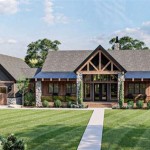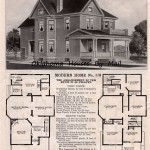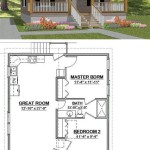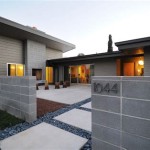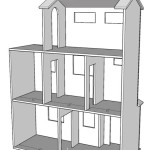Southwest Style House Plans encompass architectural designs inspired by the traditional building styles of the southwestern United States, capturing the region’s rich cultural heritage and adapting it to modern living. These plans typically incorporate elements such as adobe brick construction, exposed wooden beams, and large windows that maximize natural light and scenic views.
The allure of Southwest Style House Plans lies in their ability to create a unique and inviting ambiance, blending the charm of historic adobe homes with contemporary functionality. Whether it’s a rustic retreat or a luxurious estate, these plans offer a distinctive style that evokes the spirit of the American Southwest.
As we delve deeper into the nuances of Southwest Style House Plans, we’ll explore the key features, design principles, and construction techniques that make them a captivating choice for homeowners seeking a blend of traditional aesthetics and modern amenities.
Southwest Style House Plans embrace distinct characteristics that set them apart and create a captivating architectural style.
- Adobe Brick Construction
- Exposed Wooden Beams
- Large Windows
- Terraced Roofs
- Arches and Niches
- Saltillo Tile Floors
- Kiivas and Fireplaces
- Courtyards and Patios
These elements harmoniously blend to create a unique and inviting ambiance, paying homage to the rich cultural heritage of the American Southwest.
Adobe Brick Construction
Adobe brick construction is a defining characteristic of Southwest Style House Plans, deeply rooted in the architectural traditions of the American Southwest. Adobe bricks, crafted from a mixture of clay, sand, straw, and water, offer exceptional thermal mass, providing superior insulation and energy efficiency.
The thick walls of adobe homes absorb heat during the day and release it gradually at night, creating a naturally temperature-regulated indoor environment. This passive solar design reduces the need for artificial heating and cooling, resulting in lower energy consumption and a more sustainable home.
Adobe bricks also possess remarkable durability and longevity. Properly constructed adobe structures can withstand centuries of exposure to the elements, showcasing the enduring legacy of this ancient building technique.
Moreover, adobe’s natural composition contributes to a healthy indoor environment. The porous nature of the bricks allows for moisture regulation, reducing the risk of mold and mildew growth. This breathable material also promotes air quality by absorbing and releasing moisture, creating a comfortable and healthy living space.
Exposed Wooden Beams
Exposed wooden beams are a striking feature of Southwest Style House Plans, adding a rustic charm and a touch of the outdoors to interior spaces.
These beams, often made from locally sourced timbers such as pine or oak, are typically left exposed to showcase their natural beauty and the craftsmanship involved in their construction. The beams serve both a structural and aesthetic purpose, supporting the roof and adding visual interest to the home.
In addition to their aesthetic appeal, exposed wooden beams also contribute to the home’s thermal performance. The wood’s natural insulating properties help to regulate indoor temperatures, keeping the home cooler in the summer and warmer in the winter.
Furthermore, exposed wooden beams can be integrated into various design elements, such as vaulted ceilings, creating a sense of spaciousness and grandeur. They can also be used to define different areas within an open floor plan, adding architectural interest and functionality to the home.
Large Windows
Large windows are a defining feature of Southwest Style House Plans, capturing the region’s abundant natural light and stunning scenery.
These windows, often floor-to-ceiling in height and expansive in width, provide unobstructed views of the surrounding landscape, blurring the boundaries between indoor and outdoor living spaces. The generous use of windows allows natural light to flood the home, creating a bright and airy ambiance.
In addition to their aesthetic appeal, large windows also play a functional role in Southwest Style House Plans. They promote passive solar heating, allowing sunlight to enter the home during the day and heat the thermal mass of the adobe walls and floors. This stored heat is then released gradually at night, reducing the need for artificial heating.
Furthermore, large windows offer natural ventilation, facilitating cross-breezes that cool the home during the summer months. The placement and design of windows can be carefully considered to maximize airflow and create a comfortable indoor environment.
Beyond their practical benefits, large windows also contribute to the overall aesthetic of Southwest Style House Plans. They frame the surrounding landscape as a living artwork, adding a sense of spaciousness and grandeur to the home.
Terraced Roofs
Terraced roofs are a distinctive feature of Southwest Style House Plans, adding a unique architectural element that pays homage to the region’s rich cultural heritage.
- Multiple Levels: Terraced roofs consist of multiple levels or tiers, creating a stepped effect that adds visual interest and depth to the home’s exterior. These levels can be used as outdoor living spaces, offering panoramic views of the surrounding landscape.
- Energy Efficiency: Terraced roofs contribute to the energy efficiency of Southwest Style House Plans. The stepped design allows for better airflow, promoting natural ventilation and reducing the need for artificial cooling. Additionally, the thermal mass of the adobe walls and floors can be extended onto the terraced roofs, further enhancing the home’s thermal performance.
- Water Conservation: In regions with limited rainfall, terraced roofs can be designed to collect and store rainwater. This water can be used for irrigation, reducing the reliance on municipal water sources. The stepped design also slows down the flow of water, allowing it to be absorbed into the ground more effectively, reducing runoff and erosion.
- Aesthetic Appeal: Terraced roofs add to the overall aesthetic appeal of Southwest Style House Plans. Their unique shape and layered design create a visually striking element that complements the home’s other architectural features. They can be adorned with decorative elements such as tiles, railings, and pergolas, further enhancing the home’s curb appeal.
Incorporating terraced roofs into Southwest Style House Plans not only adds visual interest but also enhances the home’s functionality and sustainability, creating a truly unique and captivating architectural style.
Arches and Niches
Arches and niches are elegant architectural elements that add character and functionality to Southwest Style House Plans.
- Arches:
Arches are curved openings that create a graceful and inviting atmosphere. They can be used as entryways, windows, or decorative accents. Arches add a touch of grandeur to the home’s exterior and interior, evoking a sense of history and tradition. Their curved shape also helps to distribute weight evenly, making them structurally sound and suitable for load-bearing purposes.
- Niches:
Niches are recessed spaces in walls or alcoves that provide both aesthetic and functional value. They can be used to display artwork, sculptures, or other decorative items, adding a touch of personality to the home. Niches also create a sense of depth and visual interest, breaking up the monotony of flat walls. Additionally, they can be used to house practical items such as storage shelves or lighting fixtures, combining form and function.
- Integration with Other Architectural Features:
Arches and niches are often integrated with other architectural features in Southwest Style House Plans, such as exposed wooden beams and large windows. Arches can be used to frame windows and doors, creating a cohesive and visually appealing design. Niches can be incorporated into walls alongside exposed wooden beams, adding depth and character to the space.
- Cultural Significance:
Arches and niches have cultural significance in the American Southwest, drawing inspiration from Spanish Colonial and Native American architectural traditions. Arches are reminiscent of the Moorish and Mediterranean influences that shaped the region’s architectural heritage, while niches are often inspired by the recessed spaces found in traditional adobe structures.
Incorporating arches and niches into Southwest Style House Plans adds a touch of elegance, functionality, and cultural charm to the home, creating a unique and inviting living space.
Saltillo Tile Floors
Saltillo tile floors are a distinctive feature of Southwest Style House Plans, adding a touch of rustic charm and authenticity to the home.
- Natural Beauty: Saltillo tiles are made from natural clay, giving them a warm and earthy appearance. Each tile is unique, featuring variations in color and texture that add character to the floor. The natural beauty of Saltillo tiles complements the organic and earthy elements of Southwest Style House Plans.
- Durability and Longevity: Saltillo tiles are known for their exceptional durability and longevity. They are resistant to wear and tear, making them an ideal choice for high-traffic areas. Properly installed and maintained Saltillo tile floors can last for generations, adding to the timeless appeal of Southwest Style House Plans.
- Thermal Properties: Saltillo tiles possess excellent thermal properties, making them suitable for both warm and cold climates. The tiles absorb heat during the day, releasing it gradually at night, helping to regulate the indoor temperature. This natural thermal regulation contributes to the energy efficiency of Southwest Style House Plans.
- Low Maintenance: Saltillo tile floors are relatively low maintenance, requiring occasional sweeping and mopping. Their natural durability and resistance to stains make them easy to clean and maintain, ensuring their beauty for years to come.
Incorporating Saltillo tile floors into Southwest Style House Plans adds a touch of authenticity, durability, and warmth to the home, creating a unique and inviting living space.
Kiivas and Fireplaces
Kiivas and fireplaces are essential elements of Southwest Style House Plans, providing both warmth and ambiance to the home.
Kiivas
Kiivas are traditional Native American wood-burning stoves or fireplaces that are often incorporated into Southwest Style House Plans. They are typically made of adobe or stone and have a distinctive beehive shape. Kiivas provide radiant heat, which is ideal for warming small spaces and creating a cozy atmosphere.
In addition to their practical function, kiivas also hold cultural significance for many Native American tribes. They are often used for ceremonial purposes and are considered a symbol of the hearth and home. Incorporating a kiva into a Southwest Style House Plan adds a touch of authenticity and cultural charm.
Fireplaces
Fireplaces are another popular feature in Southwest Style House Plans, offering a more conventional way to enjoy the warmth and ambiance of a fire. They can be designed in a variety of styles, from traditional wood-burning fireplaces to modern gas fireplaces.
Fireplaces in Southwest Style House Plans often feature unique design elements such as decorative tilework, exposed wooden mantels, and intricate stonework. They serve as focal points in living rooms and family rooms, creating a warm and inviting gathering space.
Both kiivas and fireplaces contribute to the overall ambiance and functionality of Southwest Style House Plans. They provide a source of heat, create a cozy atmosphere, and add a touch of cultural charm to the home.
Courtyards and Patios
Courtyards and patios are essential elements of Southwest Style House Plans, providing seamless indoor-outdoor living and expanding the home’s living space.
- Private Outdoor Spaces:
Courtyards and patios create private outdoor spaces that offer respite from the sun and wind. They provide a secluded sanctuary for relaxation, entertaining, or simply enjoying the beauty of nature.
- Extension of Living Space:
Courtyards and patios extend the living space beyond the walls of the home, creating a seamless transition between indoor and outdoor areas. They allow for seamless flow of activities, bringing the outdoors in and the indoors out.
- Outdoor Entertainment:
Courtyards and patios provide ample space for outdoor entertainment. They can be equipped with seating areas, dining tables, and even outdoor kitchens, making them ideal for gatherings, barbecues, and other social events.
- Enhanced Natural Light:
Courtyards and patios bring natural light into the home. They act as light wells, illuminating interior spaces and reducing the need for artificial lighting. This creates a brighter, more inviting, and energy-efficient living environment.
Courtyards and patios not only enhance the functionality of Southwest Style House Plans but also contribute to their aesthetic appeal. They create a sense of harmony between the home and its surroundings, blurring the boundaries between indoor and outdoor living.










Related Posts




